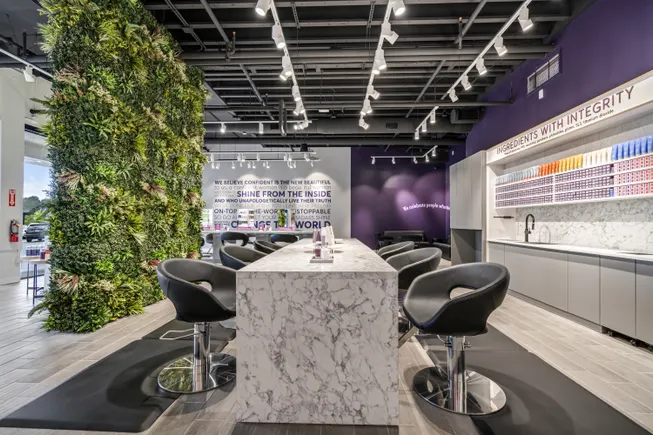Listen to the article
It’s no secret that AI agents are well suited for handling simple, low-friction tasks like scheduling appointments, while humans can excel at more complex, emotional work — like helping you decide what color to dye your hair.
Madison Reed, which specializes in hair color products and services at its salons, makes expert advice from real people a core part of its experience, according to Amy Errett, founder and CEO of Madison Reed. Customers can connect with trained cosmetologists who can answer technical questions over the phone, in a salon or via email and help them find the right look.
“The most important thing in our business is matching the right hair color with the consumer to get the outcome the consumer wants,” Errett told CX Dive. “And as you can imagine, this is a high-friction point business.”
Madison Reed’s customer support is human-centric, but AI still has a role to play. The company launched a chatbot named Madi in 2016 to help customers start their journey. Now, Madi has been upgraded with agentic capabilities that enable it to assist with product discovery, customer support and scheduling and cancellations at the company’s hair color bars.
The AI tool suite, which was soft launched in February and officially announced Wednesday, is now handling more than 90% of Madison Reed’s web traffic. Its success is due to a combination of careful planning and ensuring the tools enhance, not replace, the company’s people, according to Errett.
Use cases come first
The process of adding agentic capabilities to Madi began with establishing the three biggest use cases that could benefit customers if automated: product discovery, membership management and appointment booking.
Starting with a goal, then buying technology to support that outcome, is a good approach for rolling out customer service automation in general, according to Deborah Alvord, VP analyst with Gartner’s global customer service and support research group.
“Leaders need to know what they are trying to achieve,” Alvord told CX Dive in August. “What are the outcomes? Don’t just buy features. Make sure that there is internal agreement on what those outcomes can be, and then go to the vendors.”
Madison Reed partly based its automation targets on volume. The company derives 70% of its business from members, who get their hair colored at a regular cadence for a monthly fee, according to Errett. As a result, a large portion of the company’s customer service calls are about managing memberships — simple, administrative tasks that are well-suited for AI.
Madi’s role in high-volume customer service tasks helps train the AI as well, according to Errett. The large language models behind the agentic capabilities improve themselves as they address more customer questions by building up on its knowledge base.
For example, about 18% of Madi’s use has been for product discovery, according to Errett. As the chatbot learns more about customers based on how they fill out Madison Reed’s hair quiz — including how different kinds of hair, color preferences and product regimes connect — it can better personalize its recommendations for customers.
Listening powers evolution
Careful listening powered Madi’s agentic evolution.
At first the chatbot only addressed a small portion of customer traffic, gradually working up to the level it handles today, according to Errett. Madison Reed was constantly monitoring Madi to keep an eye on where it fell short.
“If certain questions aren’t getting answered correctly and the customer’s not getting satisfaction, you know that pretty quickly,” Errett said. “So I would say that by the time we went into almost full automation, we had a pretty good handle of those things that would still require human interaction.”
Careful listening is another key part of any successful agentic AI rollout, according to Alvord. Companies that analyze their customer service traffic can better separate easily automated interactions from those that require the human touch.
AI agents now handle about 60% of Madison Reed’s phone traffic, and despite the change, the company has maintained net promoter scores in the 70s, Errett told CX Dive. She attributes the success to the AI’s focus on basic tasks, leading to benefits like faster appointment booking.
“More people probably feel like they’re not waiting on their phones,” Errett said. “They’re not waiting for an email response. Their chat is happening quicker. So I think all in all, it’s been very successful.”
A human is always a button press away
People will always have an important place in Madison Reed’s business, according to Errett.
“There’s an emotional human interaction that’s happening as somebody is working on your appearance,” Errett said. “And that is something that is not going to change at Madison Reed just because we have an agent called Madi. We’re here as human beings to meet the customer where they need to be met.”
Madi is designed to add more options for customers, not to take them away, according to Errett. Madison Reed’s interactive voice response system and Madi’s web interface each provide options for customers to connect with a live agent at any point.
When customers use AI to book their appointments, it actually frees up Madison Reed’s stylists to improve the in-salon experience, according to Errett. The more times a stylist has to interrupt a coloring session to take a call, the less enjoyable it will be for the customer in the store.
Robots aren’t going to take over high-touch jobs like doing someone’s hair, Errett said. But AI can automate low-stake tasks like telling your stylist you’re running 10 minutes late, which lets the people in the salon spend more time helping other people.
“I want to assure people that there is more opportunity coming out of this than the diminishing return of elimination of roles,” Errett said. “I think that human beings deserve that, and I think our business is at the epicenter of that.”


